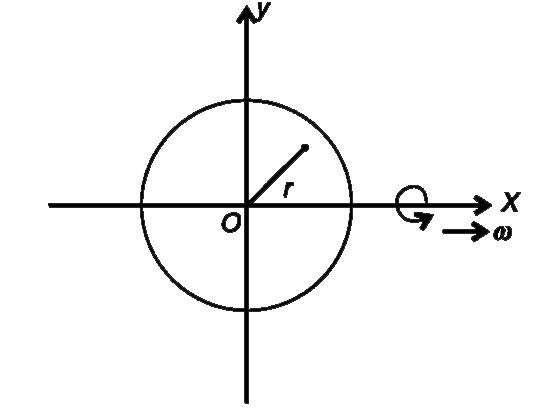A uniform ball of mass M and radius R can rotate freely about any axis through its centre. Its angular velocity vector is directed along positive x axis. A bullet is fired along negative Z direction and it pierces through the ball along a line that is at a perpendicular distance from the centre of the ball. The bullet passes quickly and its net effect is that it applies an impulse on the ball. Mass of the bullet is m and its velocity charges from u to as it passes through the ball. As a result the ball stops rotating about X axis and begins to rotate about y axis. The angular speed of the ball before and after the hit is . Find .

The correct Answer is:
Topper's Solved these Questions
Similar Questions
Let →u be the initial velocity of a particle and →F be the resultant force acting on it . Describe the path that the particle can take if
(a) →u×→F=0and→F=constant
(b) →u.→F=0and→F=constant
In which case can the particle retrace its path .
View SolutionTwo particles of mass m1 and m2 are connected by a spring of natural length L and force constant k. The masses are brought close enough so as to compress the spring completely and a string is used to tie the system. Assume that length of spring in this position is close to zero. The system is projected with a velocity V0 along the positive x direction. At the instant it reaches origin at time t = 0, the string snaps and the spring starts opening.
(a) Show that the mass m1(orm2) will are perform SHM in the reference frame attached to the centre of mass of the system. Find the time period of oscillation.
(b) Write the amplitude of m1 and m2 as a function of time. lt( c) Write the X co ordinates of m1 and m2 as a function of time

View SolutionFind the moment of inertia of a cylinder of mass M , radius R and length L about an axis passing through its centre and perpendicular to its symmetry axis. Do this by integrating an elemental disc along the length of the cylinder.
View SolutionA ball rolls without slipping. The radius of gyration of the ball about an axis passing through its centre of mass is k. If radius of the ball be R, then the fraction of total energy associated with its rotation will be.
View SolutionA ring of mass m and radius r rotates about an axis passing through its centre and perpendicular to its plane with angular velocity ω. Its kinetic energy is
View SolutionA ball rolls without slipping. The radius of gyration of the ball about an axis passing through its centre of mass is K, If radius of the ball be R, then the fraction of total energy associated with its rotational energy will be
View SolutionA solid sphere of radius r and mass m rotates about an axis passing through its centre with angular velocity ω. Its K.E. Is
View SolutionA ball rolls without slipping. The radius of gyration of the ball about about an axis passing through its center of mass is K. If radius of the ball be R, then the fraction of total energy associated with its rotational energy be
View SolutionCalculate the moment of inertia of a disc of radius R and mass M, about an axis passing through its centre and perpendicular to the plane.
View SolutionThe moment of inertia of a circular disc of mass m and radius r about an perpendicular axis passing through its centre is
View Solutionएक गेंद बीना फिसले लुढ़कती है इसके द्रव्यमान केंद्र से गुजरने वाली अक्ष के सापेक्ष गेंद की परिभ्रमण त्रिज्या K है
यदि गेंद की त्रिज्या R है
घूर्णी ऊर्जा का कितना अंश है :-
View SolutionA ball rolls without slipping. The radius of gyration of the ball about an axis passing through its centre of mass is K. If radius of the ball be R, then the fraction of total energy associated with its rotational energy will be …………..
View SolutionA ball rolls without slipping. The radius of gyration of the ball about an axis passing through its centre of mass is k . If radius of the ball be R , then the fraction of total energy associated with its rotation will be.
View SolutionA ring of mass m and radius r rotates about an axis passing through its centre and perpendicular to its plane with angular velocity ω. Its kinetic energy is
View SolutionA ball rolls without slipping. The radius of gyration of the ball about about an axis passing through its center of mass is K. If radius of the ball be R, then the fraction of total energy associated with its rotational energy be
View Solution
